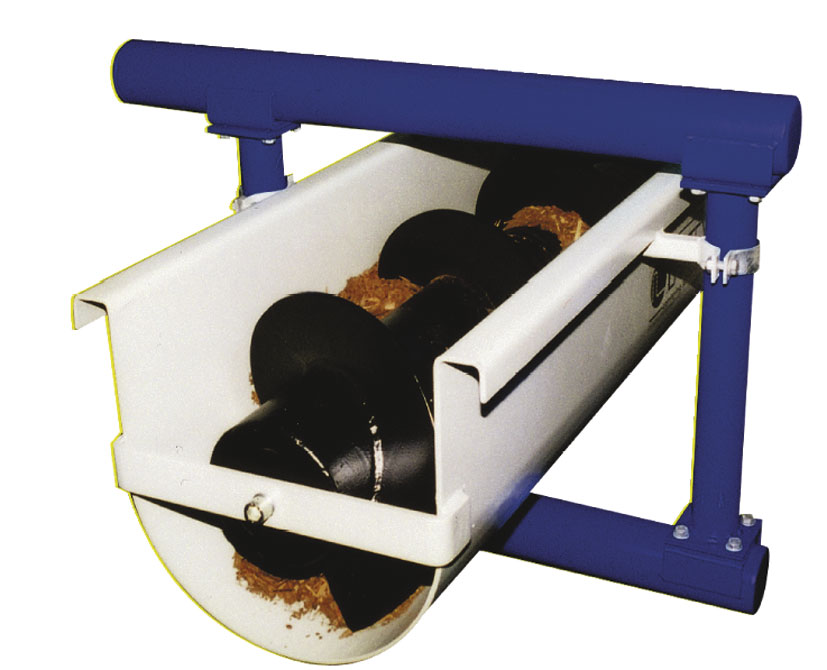Conveying Joins The Nuclear Age

Non-contact mass flow measurement for screw, drag, bucket and belt conveyors
Continuous monitoring of the mass flow or weight of solids is a vital area of process control in solids measurement, particularly in quarries and aggregates handling. The challenges for instrumentation are many, eg dust, abrasion and impacts, varying bulk densities, changing moisture levels, build-up, particle sizes and vibration.
‘In-line’ weighing systems in the aggregates and quarrying industries come in a variety of technologies depending on the product and conveyor type, formats include ‘loss-in-weight’ systems, impact and dynamic belt-weighing systems. They all involve various levels of process contact and/or precious plant space for isolation of process for the weighing of material at a point in time, and all involve some mechanical moving parts, which is not ideal when handling abrasive products.
Another option is the indirect measurement of product flow though screw and drag conveyors via motor load consumption, acoustics or suspending conveyors and chutes on load-cells. These have proved generally unreliable, high in maintenance and inaccurate.
These factors can make many existing systems’ cost of ownership high, resulting in lost production, time and money spent on repair, unscheduled maintenance and specialist recalibration — depending on the device, material and environment they are used in.
Another way ‘around’ the problem
Another alternative to consider, is the use of an externally mounted, low-energy, high-sensitivity nucleonic system ‘around’ the conveyor, with no intermediate machinery or additional space needed. Although the installation cost may be higher, the benefits of this type of system include:
- No moving parts, therefore no mechanical wear or drift
- Installation on screw, chain or belt conveyors without major modifications
- Little space required and no relaxation section required for mass flow
- Measurement possible even during free fall of product
- Low source activity due to the use of highly sensitive scintillation detectors
- Extreme long-term stability provided by digital electronics and decay compensation
- Calibration check on the empty conveyor system by a standard absorber
- Determination of the dry weight is possible with an existing moisture signal
- Proven in thousands of applications worldwide.
Concern over the use of radiation is the normal response. However the system is worth considering a little more carefully in light of the potential benefits outlined above and the demand for more predictive maintenance and ‘fit-and-forget’ equipment.
The source output levels are lower than ever, due to improvements in electronics and sensors, and the radiation beam is also tightly collimated and directed only at the detector.
Safety is carefully controlled and the sources held in very sturdy containers, with source ‘sizes’ always kept to the minimum.
How does it work?
As shown in figure 3, the nucleonic system is mounted completely outside the process. A small gamma radiation source, just strong enough for the anticipated path length and materials, directs a collimated beam at the detector mounted on the opposite side of the conveyor.
The source beam is attenuated by the product and the signal reaching the detector is inversely proportional to the weight of product passing through the beam, ie with more product present the lower the energy at the detector. The detector measures the amount of radiation reaching it and can combine this with an input of conveyor or screw speed to provide conveyor loading and total weight.
This simple yet highly effective technique can deliver an accuracy of up to 2% on the most arduous applications with a very high degree of reliability. Other nucleonic systems use the same basic signal attenuation technique to measure density, level or product interfaces in both solids and liquid applications in many industries.
How does it work in practice?
The system can be applied on almost any size of conveyor and almost any product — from coarse aggregates to fine powders. It can be easily installed without interrupting the process as it is non-contact and clamps around the conveyor; it is also suitable for hot processes.
Simple external caging to prevent access to the beam when the source shutter is open is normally required. Comprehensive support and advice is provided by the supplier with a final inspection to produce a Critical Examination Report taking place before commissioning and start-up of the system. This will ensure the installation meets all the requirements of the Ionising Radiation Regulations (IRR1999).
Installation, commissioning and operation
Source holders are safe to handle with low levels of external radiation when the shutter is closed; they are also approved transport containers. The design of the holder is such that no access to the source pill is possible by site personnel. A lockable shutter allows site technicians to install a system safely and isolate the source during any routine work on the conveyor.
Because of their reliability, ongoing maintenance is planned and routine, not reactive, as the systems have integral compensation for source decay and there are no moving parts. Initial calibration of the system by the supplier is straightforward, and once calibrated accuracy can be maintained by zeroing the system with the conveyor empty to take account of any build-up or wear within the conveyor.
Some companies may already be using nucleonic gauges for hopper level switches etc and will therefore already be registered and have systems in place to use this type of equipment. New users will need to register with the Environment Agency and appoint a radiation advisor to ensure compliance with current legislation.
Competent system suppliers will provide all the information, support and help with the paperwork needed to register the system and guide customers through the procedures. This type of product is in common useage in many industries across the UK and worldwide, and an excellent support and regulation infrastructure already exists for this reliable answer to difficult measurement and process control situations.
The author, Gary Baker, is general manager of VEGA Ohmart Nucleonic Instrumentation


